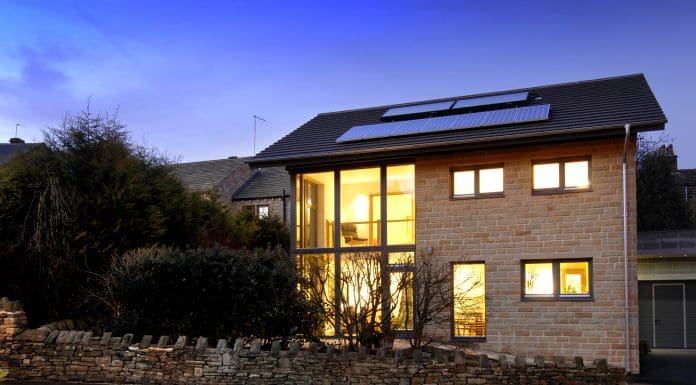Current Building Regulations are inadequate in ensuring energy efficiency in new homes. We must go beyond them to achieve comprehensive building assessments that measure energy consumption – with the current EPC system being notoriously inaccurate – as well as sound levels, relative humidity and CO2 levels, argues Andy Mitchell of 21°
Building regulations are designed to ensure energy efficiency in new homes, but often these standards fall short of their intended goals. In England, we’re subject to Building Regulations that have three parts that are pertinent to energy efficiency: Part L (energy and carbon emissions), Part O (overheating), and Part F (ventilation).
Part L relies heavily on the Standard Assessment Procedure (SAP), a tool that predicts a building’s energy efficiency based on its design parameters, and that in turn generates a home’s Energy Performance Certificate (EPC).
The inadequacies of current Building Regulations on energy efficiency
In practice, there are significant gaps between the regulations and real-world performance, with leading research showing that, at a conservative estimate, newly built homes require 60% more heating than their certificate indicates. This is because the SAP tool often lacks the necessary detail to provide accurate energy efficiency predictions, lacking the level of granularity required.
Additionally, there’s frequently a gap between how buildings are designed and how they are constructed. Builders may not install materials according to the specifications, compromising energy performance, or the details drawn in the design prove practically challenging to install.
The construction industry suffers from inconsistent quality checks. Without rigorous, ongoing oversight and commissioning and post-construction assessment, buildings often do not perform as designed.
Beyond SAP: Seeking better solutions
To address these shortcomings, SAP needs to be transformed from a compliance tool into a comprehensive design instrument, similar to the Passivhaus Planning Package (PHPP).
This tool allows for more accurate predictions, insisting on a greater level of detail and allowing for different elements to be adjusted to discover the best way to create a high-performance home.
Also, the specification process for the energy performance of a home needs improvement. For example, when it comes to heat pumps, current standards, such as the Microgeneration Certification Scheme (MCS), do not account for elements like mechanical ventilation with heat recovery (MVHR).
With heat recovery not included in the calculation, this leads to over-specification of the heat pump, which often means it’s more expensive to run as it is less efficient. Enhanced training for architects, contractors and well-trained building control operatives is essential, and higher benchmarking standards are needed to ensure components like ventilation and energy use are harmoniously integrated.
Why it’s vital to go beyond regulations
Homes should be recognised as places of dwelling for rather than financial assets. Properly designed homes contribute significantly to both physical and mental health.
A high-performing home will maintain a radiant heat of 21°C +/- 4°C for optimal human comfort, while improved air quality and humidity levels have a direct impact on the rate of recovery from respiratory illness.
Investing in better homes is not just about immediate financial return but about enhancing quality of life. For example, while improving one element, such as insulation, might have a long period before any financial gains are made, the immediate benefits in terms of comfort and health are substantial.
Instead of viewing our homes as assets, we need to consider the amount of time we spend within them and how they serve our day-to-day lives, now and in the future. After all, financial gains on a home are not often realised unless a home is sold for the purpose of downsizing.
Long-term impacts and the role of government
Poor-quality housing is linked to health issues, which burden the NHS and reduce the nation’s productivity.
The new Labour government’s commitment to updating planning laws and building higher-quality infrastructure presents a massive opportunity. By setting high standards for decarbonisation and energy efficiency, the government can ensure new housing is both fit for purpose and conducive to better living standards.
The incoming Future Homes Standard 2025 proposes that a Home Energy Model (HEM) will replace SAP and it may have a greater level of granularity, but this is not yet confirmed.
Currently, the government doesn’t have accurate, proven methodologies so one option could be to allow architects, developers and other stakeholders to use an alternative “deemed-to-satisfy” methodology, such as PHPP – a platform that has a 30-year track record of accurate forecasting of energy use in over 60,000 buildings.
Homes fit for the future
Building better homes involves considering the entire system rather than individual elements. This means ensuring that core components, such as windows, doors, heating, ventilation, airtightness and insulation are correctly integrated. The focus should be on ensuring all elements work together seamlessly, ensuring overall building performance.
Moving beyond compliance in Building Regulations is vital for creating homes that have the best interests of their occupants in mind. Addressing the gaps in current standards, advocating for better tools and training, and adopting a holistic approach to building assessments can ensure new homes are not only energy efficient but also conducive to health and wellbeing.
Promoting better standards, comprehensive assessments and a shift in how homes are viewed is crucial. Only by going beyond compliance can a built environment be created that meets the needs of its occupants and stands the test of time.
The post Beyond compliance: Why Building Regulations fall short on energy efficiency appeared first on Planning, Building & Construction Today.


